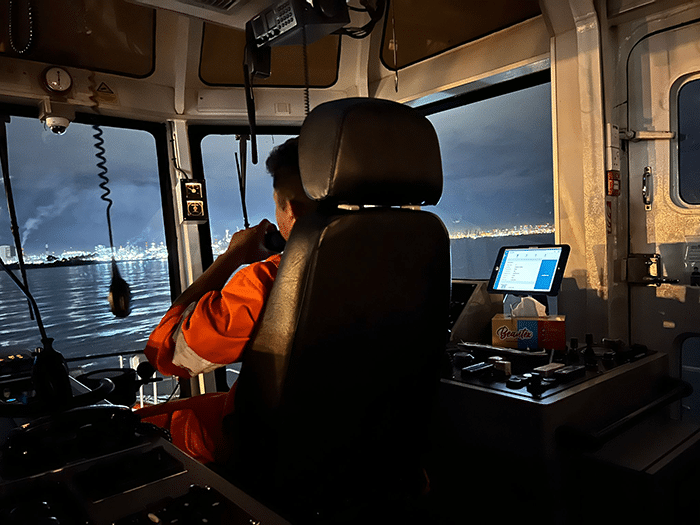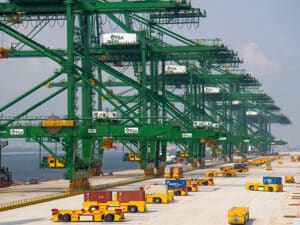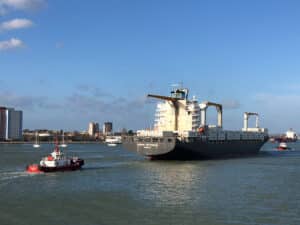
Op-Ed: How to harness AI for greener ports
Written by
Tugboat and pilotage operations at a port. Credit: Innovez One
By Grant Ingram, CEO of Innovez One for EMEA
Ports must reinvent themselves as part of the decarbonized supply chains of the future. Artificial intelligence can give them a solid helping hand, but those deploying it must develop and train algorithms wisely to ensure safe operations.
By nature, ports are complex ecosystems, with multiple moving parts that must fall into place seamlessly to make sure that everything, from berths to tug and pilotage services, is ready to welcome ships exactly when they arrive.
But the decarbonization transition is about to take this complexity to new heights. Ports will take on evolving roles as hubs for new low-carbon fuels and onshore electricity, which will impact everything from infrastructure decisions to berth allocation. Going forward, vessels will be powered by different types of fuels and clean technologies, making their needs for port services even more varied and specific. Managing this complexity efficiently will be vital to thrive in the low-carbon era.

For ports, there is a clear business case to embrace their new role as facilitators for sustainable shipping; those who become smarter and more sustainable today will be best placed to seize business opportunities in the nascent low-carbon economy. Green ports can already play a key role in supporting offshore wind farm projects. Further ahead, they could become sites for the production, storage, and distribution of green hydrogen, or the handling of liquefied carbon from carbon capture and storage systems.
But where to start? New challenges call for new solutions, and the good news is that ports have a powerful asset in their toolkit: artificial intelligence (AI).
AI already has a track record of powering breakthroughs in sectors as varied as finance and drug discovery. We also know that it can boost the efficiency and sustainability of port operations, because it is already doing so in ports including major hubs like Tanjung Priok and Tanjung Pelepas. Our experience with those ports yields valuable lessons about how we can make the right choices to ensure that AI-powered solutions are adapted to our sector, safe and reliable.
Training is everything
Firstly, those supplying AI solutions must ensure that algorithms are developed and trained judiciously for such safety-critical settings as port and shipping operations, where there is no room for mistakes. Unlike chat bots that have grabbed headlines recently, we can’t experiment with port efficiency and safety.
In practice, we can achieve this with a carefully curated dataset and clear parameters. For example, using machine learning, our MarineM algorithm “learns” from a port’s data to predict the duration of each job depending on the ship type and services required, based on which it deploys resources such as tug and pilot boats in the most efficient way.
By solving these complex puzzles far beyond what humans and spreadsheets can achieve, artificial intelligence helps ports deliver tangible decarbonization impact. Optimizing tug and pilotage operations eliminates unnecessary journeys, thereby slashing the overall distance traveled by those fleets and the amount of carbon they emit. Furthermore, this minimizes congestion and idling times for visiting ships, which helps them reduce their greenhouse gas emissions in the critical “first and last mile” of their journey at sea.
For example, in Tanjung Priok, our AI-powered MarineM system has reduced the overall distance traveled during tug and pilot operations by 20% and slashed average waiting times for visiting ships from 2.4 hours to 30.6 minutes.
Tailored solutions
The second takeaway is that AI-powered systems evolve together with the ports where they are deployed. Algorithms will continue to sharpen their accuracy with time, learning continuously as new data comes in. Therefore, the solutions offered will be unique and tailored to each port, as the algorithm has been trained on their unique dataset, taking into account port-specific operations and constraints.
The other implication is that machine learning could be applied to more areas of port operations, and new problems to solve. For example, we can imagine a future where AI-powered algorithms would be trained to assess and predict levels of port congestion, which could help ports identify critical situations, and take early action to ease congestion.
We will undoubtedly see more applications of AI in the future, supporting ships, ports and harbour craft at a time when they are pressured to decarbonize and playing new roles in the sustainable supply chains of the future. Throughout this transformation, we need to keep the same focus on solid and reliable results to harness its full potential safely.




